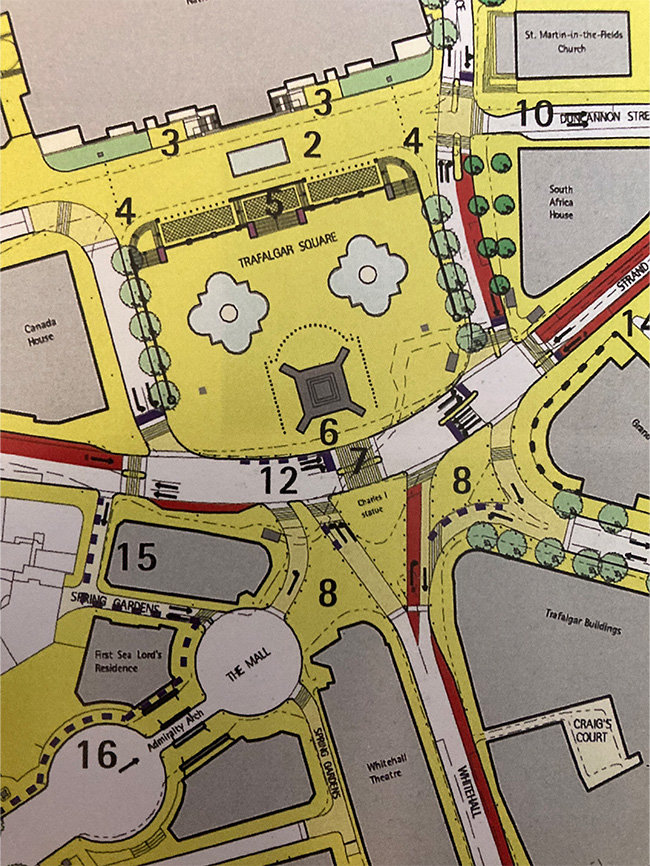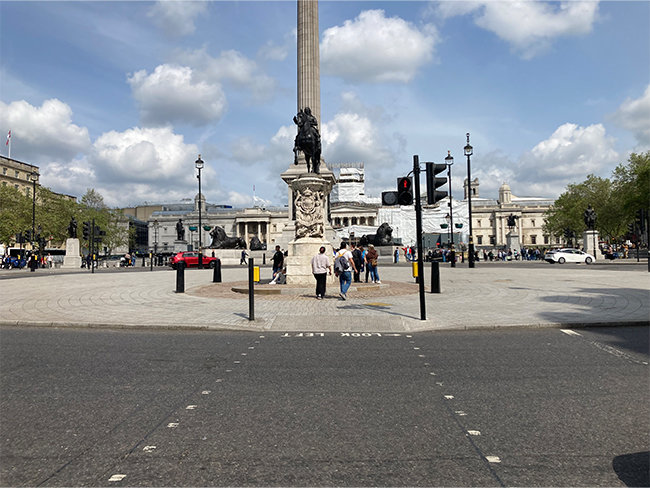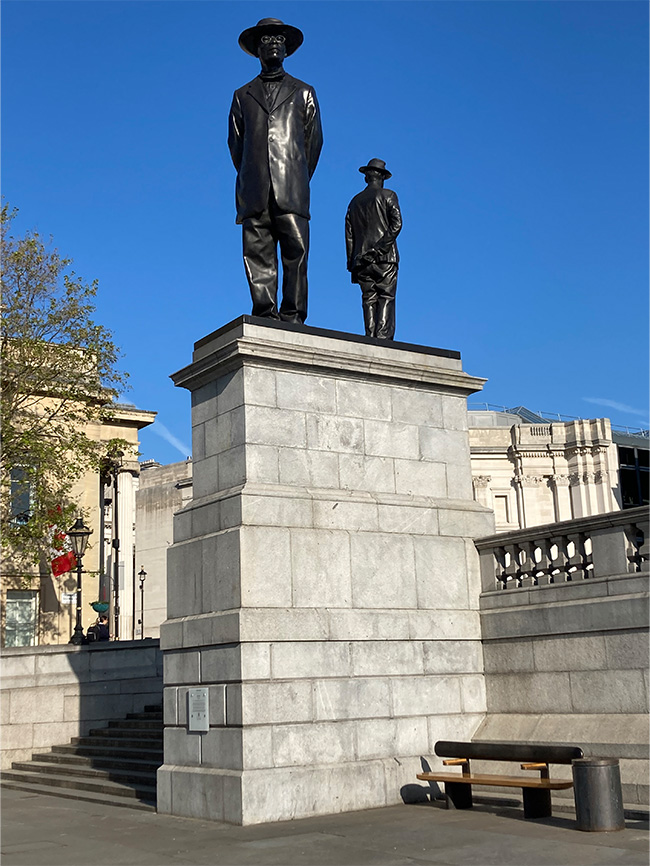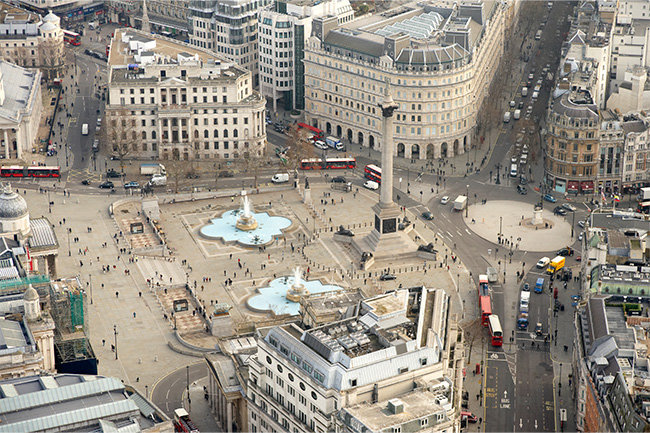On the 2nd July 2003, after seven years of planning, design and delivery, the transformation of Trafalgar Square was officially complete. Now, 20 years on, architect and town planner Peter Heath - a key member of the AtkinsRéalis team leading the project - reflects on the huge undertaking, its lasting benefits, and its ongoing influence on urban development across the world.
Trafalgar Square is one of London’s iconic landmarks, perhaps its most iconic. Yet, largely unknown to most of the 7,000 people who cross the square hourly at peak times, it was once quite different, and not so easily traversed. If you were a Londoner at the turn of the millennium, perhaps you’d remember awkwardly skirting the square’s crowded edges on narrow footways, the long delays at insufficient pedestrian crossings, or dashing across fast-moving traffic routes.
That changed in 2003, when then Mayor of London Ken Livingstone, the Greater London Authority and Transport for London client team officially reopened the square. Many of the eye-catching elements enjoyed by so many today - the grand central staircase leading up to the National Gallery, the bustling, lively pedestrian space in front of the National Gallery - all blend in seamlessly with the rest of the Victorian architecture, but in reality, have only just turned 20.
Trafalgar Square still stands out today as a remarkable project. It successfully combined both traditional and future-facing elements to provide an example of how heritage can be celebrated and integrated with our modern cities, whilst delivering a complex project on time and on schedule. So as we look forward in search of how to create meaningful, thriving and sustainable urban spaces, we should also look back to this historic scheme, and its lessons in turning stressful congestion into an urban oasis.
Back to the future
In 1996, this was all still a long way off. For years prior, tackling London’s big traffic problem had been a political quagmire, leaving London’s greatest squares to languish as enormous traffic roundabouts. But pressure was growing to change this status quo, and through an international tender for the World Squares for All initiative, a grouping of organisations, ultimately led by AtkinsRéalis, including Foster & Partners, Speirs and Major and the Joint Mobility Unit, together implemented a master plan to strategise public realm improvements for north and south of Trafalgar Square (Phase I), Whitehall from St James's Park to the Thames riverside (Phase II) and around Parliament Square (as yet an unfinished Phase III). Trafalgar Square led the way, demonstrating what can be done.

Detailed, multidisciplinary master plans are now commonplace. But at the time this was pioneering work - public realm improvement projects were few and far between across the country, let alone master plans for them. To make it work, a number of disparate goals had to be brought together into one unified vision. Transportation experts focused on fixing the traffic, strategic experts on pedestrian movements between the capital’s major thoroughfares, and the architects and landscape team brought the details to life - the sight lines, the qualities of space between buildings. This took a lot of skill to communicate to the public and decision-making bodies, but it was still extraordinary that by the end of the master plan phase, we had wide consensus to move forward with such a sensitive project - after all, we were quite literally demolishing and rebuilding part of a singular heritage site right in the centre of London.
Squaring the circle

What was transformational about this scheme was that it wasn’t just about converting a roundabout, but creating a shared surface available to pedestrians. Reclaiming back the carriageway on the north bank led to more safety, more capacity for visitors, and an opening up of invaluable space to the creative talents of the capital. Yet the potential for benefits was matched by the potential risks - the historic roundabout was the meeting place for traffic from several busy arterial routes.
To combat concerns about grid-lock traffic, a great deal of planning went into maintaining the connectivity of all the tributary roads, and conducting a thorough pedestrian analysis to correctly place the signalised crossing points. This analysis ended up being a very sophisticated way of representing and explaining the shape of our solution, and helped focus the pedestrianisation scope of the project to the north side of the square. And it helped transform a roundabout with virtually no pedestrian movement into a major thoroughfare.
As it turned out, the original master plan idea for dealing with the main traffic junction was actually mistaken. Instead of a very complicated arrangement, the project team realised the best solution was a big elliptical signalised roundabout centred around the 17th century statue of King Charles I, maintaining a safe vantage point for some of London’s most spectacular views and efficient traffic flow. But this remains a salutary reminder that innovative, bold ideas are essential. One of the striking lessons of the whole project is that we mustn't lack the courage to take on complex traffic systems. Returning two directions to one-way systems might run against common sense, but it can also create a huge amount of safer pedestrian space.
It’s equally important that future designers are mindful about inclusivity, flexibility and accessibility. We learnt that mid-journey at Trafalgar, when many important design considerations were later added into the master plan. The creation of a new staircase mandated disabled access measures between the different levels, whilst the increased capacity necessitated accessible public toilets. It also became clear that a comprehensive management plan was required to sustain the site. The contract for highways, landscape and traffic management works was therefore significantly expanded to incorporate these additional architectural proposals, including a café and most significantly, facilities for the landscape management of the square by a team of 'Heritage' Wardens, which has since contributed to a crime reduction of approximately 55% in the area.
A new traditional
Trafalgar Square is unique. But it nonetheless offers valuable lessons for future pedestrianisation initiatives in how to sensitively manage the challenges of old, whilst integrating the new. By using a large amount of materials sourced sustainably from the UK - York stone from Halifax and granite from Cornwall - we remained faithful to the square’s original feel with its neutral-light colours. Indeed the walls and balustrade flanking the grand stair used recycled historical nineteenth-century granite that was originally part of the North Terrace retaining wall. Twenty years on, that clever continuity is demonstrated by the seamless union of old and new.

The lived experience, in contrast, has been transformed. Air and noise pollution levels have been reduced by about 25%, and new strategic walking routes have been established between the South Bank and Soho, via the then new Queen’s Golden Jubilee footbridge. This has led to increased footfall, providing an environmentally attractive and sustainable alternative to other congested transport modes. So too has the pedestrianisation scheme encouraged art to flourish. A programme of cultural events now regularly lights up the square, whilst schemes such as the Fourth Plinth project - a rolling contemporary art exhibit sited on Trafalgar Square’s unfinished fourth plinth (developed in tandem with the pedestrianisation), continues to bring life and colour to millions.

As it celebrates its 20th anniversary of pedestrianisation, Trafalgar Square stands as a testament to successful urban revitalization. To create thriving places for people, it’s clear we need more of those small victories for pedestrians - wider footways, more green space and cleaner air. What we achieved at Trafalgar Square demonstrated that we can overcome the numerous obstacles of sensitive, complex locations, bring together disparate stakeholders into a shared vision, and create vibrant public spaces whilst preserving our historic fabric. Public realm improvement schemes, from down the road at Regent Street to across the country in Bristol, continue to build on that work. The fact that we’re still inspiring others to take up the mantle is perhaps Trafalgar Square’s most singular legacy. Time will always remain the greatest test. But at Trafalgar Square, 20 years on, our design is still passing with flying colours.
Please note that you are now leaving the AtkinsRéalis website (legal name: AtkinsRéalis Group inc.) and entering a website maintained by a third party (the "External Website") and that you do so at your own risk.
AtkinsRéalis has no control over the External Website, any data or other content contained therein or any additional linked websites. The link to the External Website is provided for convenience purposes only. By clicking "Accept" you acknowledge and agree that AtkinsRéalis is not responsible, and does not accept or assume any responsibility or liability whatsoever for the data protection policy, the content, the data or the technical operation of the External Website and/or any linked websites and that AtkinsRéalis is not liable for the terms and conditions (or terms of use) of the External Website. Further, you acknowledge and agree that you assume all risks resulting from entering and/or using the External Website and/or any linked websites.
BY ENTERING THE EXTERNAL WEBSITE, YOU ALSO ACKNOWLEDGE AND AGREE THAT YOU COMPLETELY AND IRREVOCABLY WAIVE ANY AND ALL RIGHTS AND CLAIMS AGAINST ATKINSRÉALIS, AND RELEASE, DISCHARGE, INDEMNIFY AND HOLD HARMLESS ATKINSRÉALIS, ITS OFFICERS, EMPLOYEES, DIRECTORS AND AGENTS FROM ANY AND ALL LIABILITY INCLUDING BUT NOT LIMITED TO LIABILITY FOR LOSS, DAMAGES, EXPENSES AND COSTS ARISING OUT OF OR IN CONNECTION WITH ENTERING AND/OR USING THE EXTERNAL WEBSITE AND/OR ANY LINKED WEBSITES AND ANY DATA AND/OR CONTENT CONTAINED THEREIN.
Such waiver and release specifically includes, without limitation, any and all rights and claims pertaining to reliance on the data or content of the External Website, or claims pertaining to the processing of personal data, including but not limited to any rights under any applicable data protection statute. You also recognize by clicking “Accept” that the terms of this disclaimer are reasonable.
The information provided by Virtua Research cited herein is provided “as is” and “as available” without warranty of any kind. Use of any Virtua Research data is at a user’s own risk and Virtua Research disclaims any liability for use of the Virtua Research data. Although the information is obtained or compiled from reliable sources Virtua Research neither can nor does guarantee or make any representation or warranty, either express or implied, as to the accuracy, validity, sequence, timeliness, completeness or continued availability of any information or data, including third-party content, made available herein. In no event shall Virtua Research be liable for any decision made or action or inaction taken in reliance on any information or data, including third-party content. Virtua Research further explicitly disclaims, to the fullest extent permitted by applicable law, any warranty of any kind, whether express or implied, including warranties of merchantability, fitness for a particular purpose and non-infringement.
The consensus estimate provided by Virtua Research is based on estimates, forecasts and predictions made by third party financial analysts, as described above. It is not prepared based on information provided by AtkinsRéalis and can only be seen as a consensus view on AtkinsRéalis' possible future results from an outside perspective. AtkinsRéalis has not provided input on these forecasts, except by referring to past publicly disclosed information. AtkinsRéalis does not accept any responsibility for the quality or accuracy of any individual or average of forecasts or estimates. This web page contains forward-looking statements based on current assumptions and forecasts made by third parties. Various known and unknown risks, uncertainties and other factors could lead to material differences between AtkinsRéalis' actual future results, financial situation, development or performance, and the estimates given here.
Downloads
Trade releases
